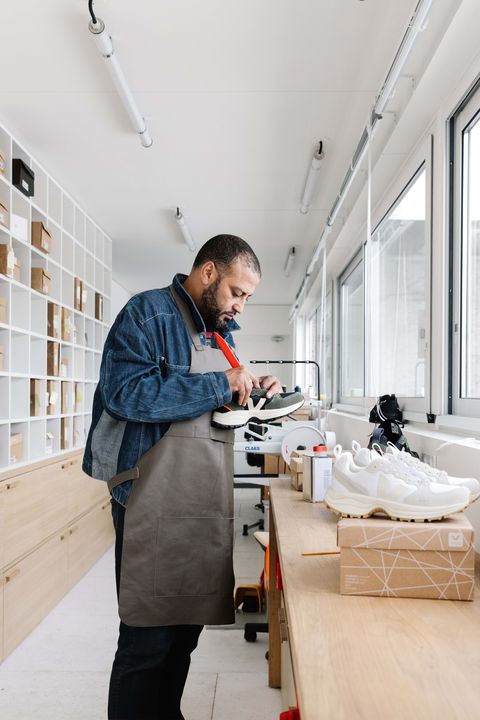people know of the French sneaker brand Veja, but they don’t know on Veja. All I can figure out by tallying sightings of Veja sneakers on the New York City subway, in the elevator at work, or in the TSA line at the airport – there are dozens of them – and then glancing take a look at the most searched questions about the brand.
Buyers aren’t necessarily looking for its history. They want to know how to pronounce Veja (“veh-ja” with a hard J, FYI) and the exact sneaker designs worn by Duchess Meghan and Emily Ratajkowski.
Veja knows the economy of celebrities wearing things increases brand awareness, and several big names have helped put Veja on American shoppers’ radars. For example, “When [Meghan] wore the shoes, there were maybe 200 articles about Meghan Markle wearing Veja,” says co-founder Sebastien Kopp in an interview with Harper’s Bazaar. (He was unfamiliar with the then-adjacent royal at the time.) Traffic to Veja’s site after that fateful 2018 outfit was immediate and of tidal wave proportions. Kopp considered the sudden surge in interest “not sad, but…it meant something about our society,” he told himself. “And we didn’t go out at all to do that.”
More from Harper’s BAZAAR
“That” is participating in the side of fashion that cares more about who wears what than how it’s done, and whether it’s done responsibly. Veja’s priorities go in the opposite direction. “We like to be proud of ourselves in the mirror and know that there is [are] no atrocities in the supply chain,” says Kopp.
Here’s a look at how they do it: Amazonian rubber is mined for soles by local cooperatives and bought by Veja at many times the market price. The organic cotton for canvas uppers is carefully harvested in Peru. The logistics of all online orders, as well as the brand’s four European stores, are coordinated by Log’ins, an association employing people with disabilities in an adapted workplace. In the same warehouse where orders are fulfilled, workers are trained to repair damaged Vejas for resale. The practical details behind each of these processes are available to any buyer who wishes – Veja has published the Iliad of supply chain explainers on its website.
“You could write a book every step of the way. So many different projects, so many different people, so many people fighting for what they believe in,” says Kopp.
Focusing on harvested cotton and rubber, or inside a logistics warehouse, is not a good marketing tactic according to the brand. (In fact, the label doesn’t pay for advertising, not even freebies for the aforementioned celebrities.) Design inspiration for the team comes directly from its sourcing. Focusing on the origins of each lace and rubber sole, Kopp tells me, “You know what you work for, you know what you work for, and you know who you work for.
The average shopper visiting Veja’s SoHo or Montmartre store might not know how carefully Veja sources their sneakers. The designers, however, took notice. Veja got a stable and large cohort of collaborators to moderately tweak and update their core sneakers. This week, he released a second installment of Marni sneakers covered in Sharpie-like squiggles; past partnerships have run the gamut from pastel suede trainers with ba&sh to chunky-soled runners with Rick Owens.
Collaborations come out in dribs and drabs of about four a year, the same rate as new styles for the brand as a whole. Veja designer Caroline Bulliot believes this is much less than the usual fashion pace. When she and Kopp say the brand’s design compass is simply what they want to wear, it’s more believable because the product line is limited.
Successful designs are those that are unisex and minimalist, like the crowd-favorite Eslar, and nothing goes into production that can’t be made with pre-approved materials. “It may seem very constraining in terms of creativity, but it is often through constraint that the best ideas are born,” says Bulliot.
The pressure to design at an Amazon Prime pace is unstoppable. “If we need four years to develop, edit and finalize a new style, that’s no problem. Time is always on our side,” she adds.
Incoming collaboration requests and celebrity sightings indicate things are going well good for Veja. Kopp is reluctant to discuss the business side of the brand, or even to talk about Veja as if it were a business. “We are growing, but we don’t care. We didn’t do Veja for the money. So if Veja stays the same for 10 years, who cares,” he says.
Kopp and Bulliot recite the same party lines when I ask where the brand might go next: They “never talk about the future.” (At least, not in front of a fashion writer with a recorder.) If Veja has more lessons to learn from other collaborations, or if she’s keen to try designing shoes that aren’t sneakers, we don’t. we won’t know until those shoes are in place. shelves.
Promises can sound like persuasion. Veja is content to lead by example with what it already makes, whether buyers go there for the best production practices or the royal cameos. “Veja started working when we stopped trying to convince people,” says Kopp. “What I am convinced of, I put into Veja.” And if people want to know more, they will know.
Halie LeSavage is a New York-based writer and editor for Bazaar.com, where she covers all things e-commerce and shopping. His work has already appeared in Charm and Morning brew.






